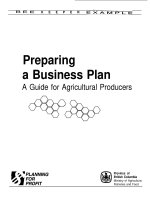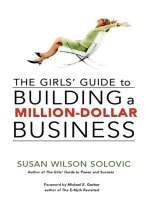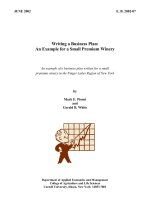The Practical Guidelines for Building a Business Plan in Five Pages
Bạn đang xem bản rút gọn của tài liệu. Xem và tải ngay bản đầy đủ của tài liệu tại đây (500.9 KB, 32 trang )
The Practical Guidelines for
Building a Business Plan in
Five Pages
T
his chapter explains the five major elements that make up the
business plan, defines the critical terms used in business plan-
ning, demonstrates how the components of a business plan fit as an
integrated model, defines logical steps in writing a business plan,
and describes the complete business planning cycle. You will learn
the activities required to implement a correct planning cycle and
the methods to develop a 5-Page Business Plan model.
25
CHAPTER
2
This chapter sets the stage for the development of the actual
business plan document. Five major elements of the business plan
are defined in specific terms. While the five are discussed as sepa-
rate elements, the information for each is developed during a sin-
gle planning session. Do not hold separate sessions to build strate-
gic plans then operational plans. The efforts would be redundant
and overlapping. Over a long period of time I tested the methods
described here with clients and found the single session to be the
most cost-effective and efficient way to manage the process. As
information is completed at the one session, it is grouped into the
five subordinate plans.
D
EFINING
Y
OUR
B
USINESS
P
LAN
A business plan is a consolidation document that defines the
parameters of how a business operates. It communicates strategic
direction as well as specific goals, methods of achieving the goals,
and the management development activities needed to reach the
vision. It is a master document that serves as an umbrella for all
events taking place within the company.
A business plan is the one place you turn to for completeness
in your story. Since it contains the key elements of both hard and
soft processes, it must be inclusive. Hard processes are those nor-
mally thought of as goals and objectives. Soft processes are the
intangible but critical elements such as values, philosophy, and
principles. In years past, planners avoided so-called soft or esoteric
processes such as values because they could not directly connect
them to the bottom line. Now smart executives work with values,
philosophies, and principles early in their planning activities. They
know the importance of integrating both the soft and hard process-
es. These executives see the relationship between goal failure and
gaps in the operational values of their companies.
An important function of a business plan is to set the direction
of the company. Setting direction means more than setting goals.
The business plan serves to tell a complete story of where you are
Seven Steps to a Successful Business Plan
26
going, how you are going to make the journey, and what business
behavior you will practice on the way. The plan becomes a road
map, blueprint, and template for employees to follow in accom-
plishing the goals:
■ The road map provides a path with markers of incremental
progress along the way. Because the plan is well defined,
employees can measure their success.
■ The blueprint feature of the business plan provides employ-
ees an overall design for the company’s actions. It shows
how the parts and pieces fit together, defines the relation-
ships, and explains the master schema of the future.
■ The template provides models for business units and teams
to build their own local action plans. If the company has
a plan, then a work team must have a plan.
Business plans should meet certain criteria. They need to be
user-friendly; therefore I present a simplified, workable document
for a complex topic. The document needs to encourage rather than
discourage its use. It needs to reflect the same goals and objectives
that people pursue each day in their work. A plan fails when its
goals are different from the work requirement. Another use of a
business plan is to provide guidance when you don’t know what to
do. This becomes the direction and benchmark for your actions.
H
OW THE
5-P
AGE
B
USINESS
P
LAN
W
ORKS
One of the main reasons resistance to business planning happens is
because of the paperwork it produces. When we think of planning
we automatically envision reams of papers, three-ring binders, and
thick bound reports. These perceptions cause people to avoid plan-
ning. It doesn’t have to be that way.
The methods I propose short-circuit some of the resistance to
planning by simplifying the documents. Over the past fifteen years
Building a Business Plan in Five Pages
27
I have helped several companies condense the bulk of their plans
down to five pages. These core plans contain the essence of what
you need to do. The often-told legend of President Lincoln writing
the Gettysburg Address on the back of an envelope holds a hidden
truth. His address was short, to the point, and told a story that cap-
tivated the audience. A second example of the brevity concept is
found in Winston Churchill’s apology to a friend about the length
of his letter: “I could have made it shorter if I had more time.” We
can build business plans using the same concepts of brevity, suc-
cinctness, and focused text. You can tell your story using a business
plan with only five components of a single page each.
The Strategic Plan—Forming the Heart of Your
Story
The strategic plan is the first of the five types of plans (as shown in
Figure 2-1). It is the starting point for the other four types of plans
and the heart of your story. Get this wrong and the rest of your plan
and your story is suspect. Get it right and the power of your people
will be unleashed because they want to know where the company
is headed. Employees want to believe that something exists in the
future. The strategic plan is a single-page document that defines
where and how you want to position your company. It examines a
list of factors that might influence your future. A diagram of how
you format the strategic plan into a single page is shown in
Appendix B: The 1-Page Strategic Plan. Topics you must address in
your strategic plan are:
■ Assumptions
■ Guidance
■ Vision Statement
■ Mission Statement
■ Strategic Goals
■ Objectives
Seven Steps to a Successful Business Plan
28
■ Strategies
■ Strategic Intent
■ Philosophy
■ Focus
■ Values
■ Principles
The Operational Plan—Bringing Your Plan to Life
The operational plan is the dynamic component that brings the
strategic plan to life (see Figure 2-2). It is the first of ten years of the
complete business plan and is developed simultaneously with the
other four components. It defines how the company accomplishes
its strategic intent on a daily or annual basis. It breaks down the
Building a Business Plan in Five Pages
29
Figure 2-1. The strategic plan sets the direction of your company.
strategic goals into objectives and tasks to make them more under-
standable and manageable. The operational plan also provides
information to executives on how well the staff carries out its func-
tional activities. Along with the execution of functional activities
comes the requirement for staff coordination. Work cannot be
effective unless it is closely coordinated across staffs or functions.
The operational plan also helps management teams implement
actions. Because it identifies the persons held accountable, the
operational plan becomes a good benchmark for reporting process-
es of key programs and projects. This becomes the benchmark for
performance measures of both the individual and the company. A
format for this plan is found in Appendix C: The 1-Page
Operational Plan.
Seven Steps to a Successful Business Plan
30
Figure 2-2. The operational plan sets the strategic plan into motion on a
practical level.
Building a Business Plan in Five Pages
31
The Organizational Plan—Defining Your
Corporate Structure
The organizational plan (seen in Figure 2-3) is the third of the five
types of plans you must develop. It defines the structure you must
have to put the complete business plan in place. Organizational
planning begins with the concept that structure follows strategy.
The strategies come from the strategic plan. The organizational
plan is more than a wiring diagram or chart showing assignments;
it must help you do certain things. First, it ensures your people are
all properly assigned to specific work or functions. Like the opera-
tional plan, the organizational plan aids coordination among criti-
cal staff sections. Another important function is cost control. The
organizational plan illustrates adjustments that need to be made to
streamline activities within the workforces. Structure should always
be tailored to the requirements. Finally, the organizational plan
must illustrate three ingredients:
Figure 2-3. The organizational plan matches the structure to the goals of
the plan.
■ A chart showing reporting relationships
■ A clear definition of responsibilities
■ A clear definition of authorities
A template for the organizational plan is found in Appendix D:
The 1-Page Organizational Plan.
The Resources Plan—Analyzing the Support You
Need to Put Your Plan Into Action
The fourth of the five types of planning is the resources plan that
can be seen in Figure 2-4. It defines the resources you must have to
support the business plan found in Appendix E: The 1-Page
Resources Plan. This plan begins with an analysis of the annual tar-
gets and the goals from the strategic plan. Normally you can devel-
op the resources plan in conjunction with the operations plan since
the two are so closely connected.
Seven Steps to a Successful Business Plan
32
Figure 2-4. The resources plan matches requirements to the overall plan.
The resources plan provides a great deal of information to the
reader because it examines specific support requirements. It con-
tains, at minimum, information on ten categories:
1.
Staffing Levels. What are your short-term and long-term
staffing requirements? What kinds of skills will be needed
at each level, now and in the future?
2.
Information Requirements. What is the volume and quality
of your information?
3.
Technology. Do you have the most effective technology to
do the job? Is technology just around the corner that will
put your competition in the advantage? What is the cost
of staying up-to-date with technology?
4.
Tools and Equipment. What supporting systems do you and
your staff need to get all the tasks completed?
5.
Intellectual Capital. How smart are your people? How smart
will they have to be in the future? What do they have to
be smart about? How are you using the intellectual capital
database that now exists?
6.
Time. What critical milestones exist in your plan? Where
are the important decision points in the plan? What can
you do to use your time more wisely?
7.
Relationships. What networks need to be developed? Can
strategic alliances and strategic partnerships help your
plan?
8.
Image. What is your image in the public perception? What
should it be? How will you develop this perception or
change a negative one?
9.
Facilities. Can you estimate the facilities requirements? Is
the need for physical space increasing or decreasing?
What effect has e-business had on your industry?
10.
Financial. Have you considered the budget constraints for
short-term requirements? What are the long-term capital
investment requirements? Do the financial numbers make
good business sense?
Building a Business Plan in Five Pages
33
The Contingency Plan—Taking Evasive Action in
a Crisis Situation
The contingency plan is the last of the five types of plan (see Figure
2-5). It is important but is often the most frequently ignored type
of plan.
Seven Steps to a Successful Business Plan
34
Figure 2-5. The contingency plan builds cases for alternatives.
There are three types of contingency planning you must con-
sider. The first is when your goals are not accomplished or are
blocked somewhere in the execution. You must have alternatives
developed to eliminate the blockage. It is a fallback position.
Normally you develop several courses of action to get you to the
goal. Multiple routes or alternatives permit you choices when the
goal path becomes blocked. You don’t change your goals, just the
actions to get you to the goals.
Another type of contingency planning is a big picture issue.
This is a disaster plan for a business-created crisis that could shut
down your company—for example, a labor strike in a plant that was
not expected or anticipated that catches management unprepared.
A contingency plan should address such occurrences.
Natural disasters are a primary contingency that companies
plan for. Like manmade situations, these occurrences can be pre-
dicted and planned for. What would happen to a business depend-
ent on landline telephone communications if a flood wiped out the
line? Remember the huge area of Quebec, Canada, that was para-
lyzed for months in the winter storm of 1998? How can you plan
for those events? What is your recovery plan?
The third type of contingency plan is developed from an inter-
nal view that examines incidents that could happen to your busi-
ness and that would cause significant concern. For example, what
would happen if members of a key management team were all
killed in a plane crash? Sad events such as this have happened
before. A contingency would have to be in place to replace those
critical people. This example is so real that at most companies it is
standard operating procedure that teams not fly together as a pre-
cautionary measure.
Another serious situation could be in the area of workplace vio-
lence. How do you prevent a serious incident from happening
inside your workplace environment? Acts of violence against super-
visors and coworkers by disgruntled employees have grown at a dis-
turbing rate in the American workplace.
1
Increasingly, embittered
employees and ex-employees are seeking revenge through violence
Building a Business Plan in Five Pages
35
and murder for alleged mistreatment on the job. According to a
Bureau of Justice, Statistics Crime Data Brief, homicide has become
the second leading cause of death in the workplace. Additionally,
statistics show that one in four workers will be harassed, threat-
ened, or attacked on the job. The topic of violence has many vari-
ables, but given the high stakes involved, it is prudent for manage-
ment to prepare to deal with workplace violence by implementing
prevention procedures. In short, this is contingency planning. An
example of the format used for contingency planning is found in
Appendix F: The 1-Page Contingency Plan.
T
IPS ON
C
APTURING
I
NFORMATION AND
M
INIMIZING
P
APERWORK
A company-level business plan is usually written in a three- to five-
day period with all members of the executive team participating.
The end product is a business plan of five single pages as outlined
in Appendices B–F. Over the past years I have helped a number of
teams accomplish this seemingly difficult task within these time
parameters. To do that successfully requires certain preconditions
and specific actions at the planning session.
One problem at a planning conference is the capturing of
information and the paperwork that follows. The only efficient way
to record information and complete the final document is to have
on-site computers and printers for the session. This allows you to
pace the discussion by producing final written documents at the
end of the session. Too much time is lost in translation if newsprint
or handwritten notes are relied upon to capture the information.
Computer support eliminates the lag time normally associated with
the planning process. At the end of the session each participant is
given a diskette with the plan and a printed copy of the plan if they
desire. Another alternative is to e-mail the final copy to all partici-
pants.
Another important tip or technique I always use is to view the
work-in-progress through an LCD projector. This provides a fast
Seven Steps to a Successful Business Plan
36









